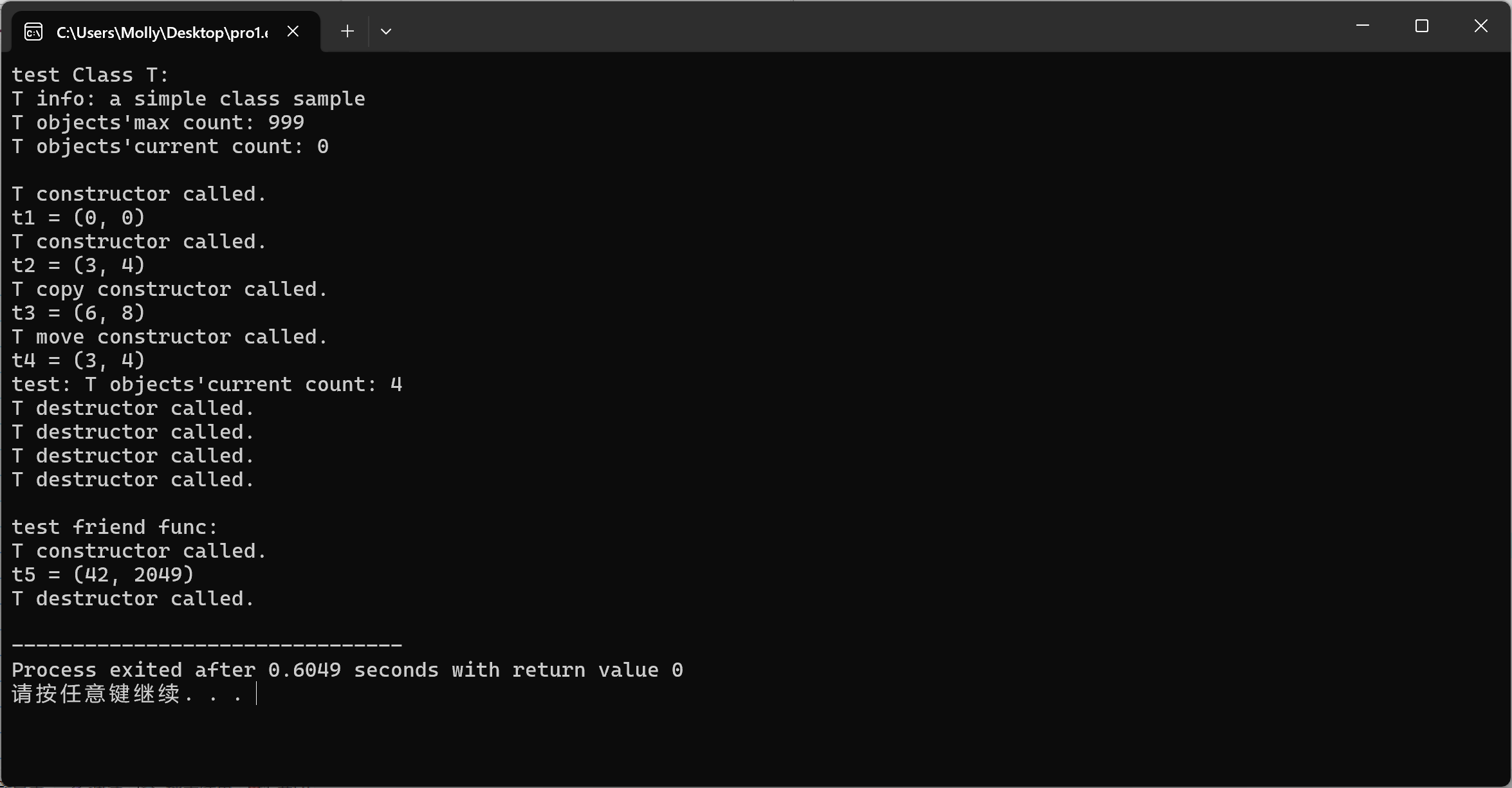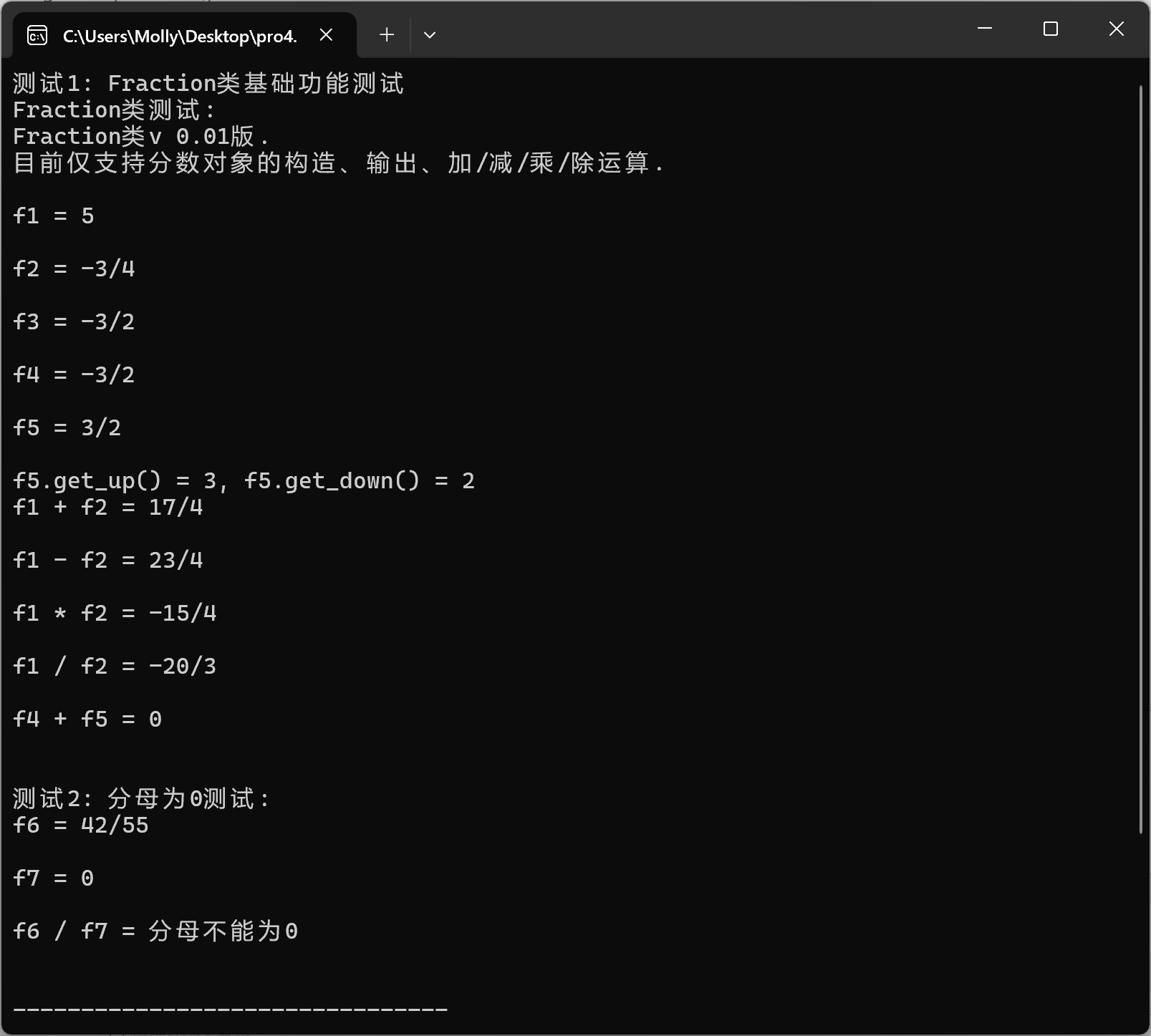实验二
任务一
T.h
#pragma once #include <string> // 类T: 声明 class T { // 对象属性、方法 public: T(int x = 0, int y = 0); // 普通构造函数 T(const T &t); // 复制构造函数 T(T &&t); // 移动构造函数 ~T(); // 析构函数 void adjust(int ratio); // 按系数成倍调整数据 void display() const; // 以(m1, m2)形式显示T类对象信息 private: int m1, m2; // 类属性、方法 public: static int get_cnt(); // 显示当前T类对象总数 public: static const std::string doc; // 类T的描述信息 static const int max_cnt; // 类T对象上限 private: static int cnt; // 当前T类对象数目 // 类T友元函数声明 friend void func(); }; // 普通函数声明 void func();
T.cpp
#include "T.h" #include <iostream> #include <string> // 类T实现 // static成员数据类外初始化 const std::string T::doc{"a simple class sample"}; const int T::max_cnt = 999; int T::cnt = 0; // 类方法 int T::get_cnt() { return cnt; } // 对象方法 T::T(int x, int y): m1{x}, m2{y} { ++cnt; std::cout << "T constructor called.\n"; } T::T(const T &t): m1{t.m1}, m2{t.m2} { ++cnt; std::cout << "T copy constructor called.\n"; } T::T(T &&t): m1{t.m1}, m2{t.m2} { ++cnt; std::cout << "T move constructor called.\n"; } T::~T() { --cnt; std::cout << "T destructor called.\n"; } void T::adjust(int ratio) { m1 *= ratio; m2 *= ratio; } void T::display() const { std::cout << "(" << m1 << ", " << m2 << ")" ; } // 普通函数实现 void func() { T t5(42); t5.m2 = 2049; std::cout << "t5 = "; t5.display(); std::cout << '\n'; }
task1.cpp
#include "T.h" #include <iostream> void test_T(); int main() { std::cout << "test Class T: \n"; test_T(); std::cout << "\ntest friend func: \n"; func(); } void test_T() { using std::cout; using std::endl; cout << "T info: " << T::doc << endl; cout << "T objects'max count: " << T::max_cnt << endl; cout << "T objects'current count: " << T::get_cnt() << endl << endl; T t1; cout << "t1 = "; t1.display(); cout << endl; T t2(3, 4); cout << "t2 = "; t2.display(); cout << endl; T t3(t2); t3.adjust(2); cout << "t3 = "; t3.display(); cout << endl; T t4(std::move(t2)); cout << "t4 = "; t4.display(); cout << endl; cout << "test: T objects'current count: " << T::get_cnt() << endl; }
运行结果截图

问题1:
T.h中,在类T内部,已声明 func 是T的友元函数。在类外部,去掉line36,重新编译,程序能否正常运行。
不能 友元函数声明不是真正的函数声明,需要独立声明
问题2:
T.h中,line9-12给出了各种构造函数、析构函数。总结它们各自的功能、调用时机
T(int x = 0, int y = 0)是普通构造函数,创建对象时将其初始化,在创建新对象时调用
T(const T &t)是复制构造函数,用一个对象去初始化另一个同类型的新对象,复制已有对象时调用
T(T &&t)是移动构造函数,引用右值初始化新对象,移动已有对象时调用
~T()是析构函数,对象被删除前清理,对象生命周期结束时调用
问题3:
T.cpp中,line13-15,剪切到T.h的末尾,重新编译,程序能否正确编译。
不能 task1.cpp和T.cpp两个重复定义
任务二
Complex.h
#ifndef COMPLEX_H #define COMPLEX_H #include <string> #include <iostream> class Complex { public: static const std::string doc; // 构造函数 Complex(); Complex(double real); Complex(double real, double imag); Complex(const Complex& other); // 接口:获取实部和虚部 double get_real() const; double get_imag() const; // 成员函数 void add(const Complex& other); // 友元函数 friend void output(const Complex& c); friend double abs(const Complex& c); friend Complex add(const Complex& c1, const Complex& c2); friend bool is_equal(const Complex& c1, const Complex& c2); friend bool is_not_equal(const Complex& c1, const Complex& c2); private: double real; double imag; }; #endif // COMPLEX_H
Complex.cpp
#include "Complex.h" #include <cmath> const std::string Complex::doc = "a simplified complex class"; Complex::Complex() : real(0.0), imag(0.0) {} Complex::Complex(double real) : real(real), imag(0.0) {} Complex::Complex(double real, double imag) : real(real), imag(imag) {} Complex::Complex(const Complex& other) : real(other.real), imag(other.imag) {} double Complex::get_real() const { return real; } double Complex::get_imag() const { return imag; } void Complex::add(const Complex& other) { real += other.real; imag += other.imag; } void output(const Complex& c) { if (c.imag >= 0) { std::cout << c.real << " + " << c.imag << "i"; } else { std::cout << c.real << " - " << -c.imag << "i"; } } double abs(const Complex& c) { return std::sqrt(c.real * c.real + c.imag * c.imag); } Complex add(const Complex& c1, const Complex& c2) { return Complex(c1.real + c2.real, c1.imag + c2.imag); } bool is_equal(const Complex& c1, const Complex& c2) { return (c1.real == c2.real) && (c1.imag == c2.imag); } bool is_not_equal(const Complex& c1, const Complex& c2) { return !is_equal(c1, c2); }
task2.cpp
#include "Complex.h" #include <iostream> #include <iomanip> #include <complex> void test_Complex(); void test_std_complex(); int main() { std::cout << "******测试1:自定义类Complex******\n\n"; test_Complex(); std::cout << "\n******测试2:标准库模板类complex******\n\n"; test_std_complex(); } void test_Complex() { using std::cout; using std::endl; using std::boolalpha; cout << "类成员测试:" << endl; cout << Complex::doc << endl << endl; cout << "Complex对象测试:" << endl; Complex c1; Complex c2(3, -4); Complex c3(c2); Complex c4 = c2; const Complex c5(3.5); cout << "c1 = "; output(c1); cout << endl; cout << "c2 = "; output(c2); cout << endl; cout << "c3 = "; output(c3); cout << endl; cout << "c4 = "; output(c4); cout << endl; cout << "c5.real = " << c5.get_real() << ", c5.imag = " << c5.get_imag() << endl << endl; cout << "复数运算测试:" << endl; cout << "abs(c2) = " << abs(c2) << endl; c1.add(c2); cout << "c1 += c2, c1 = "; output(c1); cout << endl; cout << boolalpha; cout << "c1 == c2 : " << is_equal(c1, c2) << endl; cout << "c1 != c2 : " << is_not_equal(c1, c2) << endl; c4 = add(c2, c3); cout << "c4 = c2 + c3, c4 = "; output(c4); cout << endl; } void test_std_complex() { using std::cout; using std::endl; using std::boolalpha; cout << "std::complex<double>对象测试:" << endl; std::complex<double> c1; std::complex<double> c2(3, -4); std::complex<double> c3(c2); std::complex<double> c4 = c2; const std::complex<double> c5(3.5); cout << "c1 = " << c1 << endl; cout << "c2 = " << c2 << endl; cout << "c3 = " << c3 << endl; cout << "c4 = " << c4 << endl; cout << "c5.real = " << c5.real() << ", c5.imag = " << c5.imag() << endl << endl; cout << "复数运算测试:" << endl; cout << "abs(c2) = " << abs(c2) << endl; c1 += c2; cout << "c1 += c2, c1 = " << c1 << endl; cout << boolalpha; cout << "c1 == c2 : " << (c1 == c2) << endl; cout << "c1 != c2 : " << (c1 != c2) << endl; c4 = c2 + c3; cout << "c4 = c2 + c3, c4 = " << c4 << endl; }
运行结果截图

问题1:
比较自定义类 Complex 和标准库模板类 complex 的用法,在使用形式上,哪一种更简洁?函数和运算内在有关
联吗?
标准库模板类complex用法更简洁 函数和运算逻辑上相关联
问题2:
2-1:自定义 Complex 中, output/abs/add/ 等均设为友元,它们真的需要访问 私有数据 吗?(回答“是/否”并
给出理由)
是 要访问私有成员real和imag
2-2:标准库 std::complex 是否把 abs 设为友元?(查阅 cppreference后回答)
否
2-3:什么时候才考虑使用 friend?总结你的思考。
外部函数需要访问私有成员时使用
问题3:
如果构造对象时禁用=形式,即遇到 Complex c4 = c2; 编译报错,类Complex的设计应如何调整?
改为Complex(const Complex&) = delete
任务三
PlayerControl.h
#pragma once #include <string> enum class ControlType {Play, Pause, Next, Prev, Stop, Unknown}; class PlayerControl { public: PlayerControl(); ControlType parse(const std::string& control_str); // 实现std::string --> ControlType转换 void execute(ControlType cmd) const; // 执行控制操作(以打印输出模拟) static int get_cnt(); private: static int total_cnt; };
PlayerControl.cpp
#include "PlayerControl.h" #include <iostream> #include <algorithm> #include <cctype> int PlayerControl::total_cnt = 0; PlayerControl::PlayerControl() {} ControlType PlayerControl::parse(const std::string& control_str) { std::string str = control_str; std::transform(str.begin(), str.end(), str.begin(), [](unsigned char c) { return std::tolower(c); }); if (str == "play") { total_cnt++; return ControlType::Play; } else if (str == "pause") { total_cnt++; return ControlType::Pause; } else if (str == "next") { total_cnt++; return ControlType::Next; } else if (str == "prev") { total_cnt++; return ControlType::Prev; } else if (str == "stop") { total_cnt++; return ControlType::Stop; } else { return ControlType::Unknown; } } void PlayerControl::execute(ControlType cmd) const { switch (cmd) { case ControlType::Play: std::cout << "[play] Playing music...\n"; break; case ControlType::Pause: std::cout << "[Pause] Music paused\n"; break; case ControlType::Next: std::cout << "[Next] Skipping to next track\n"; break; case ControlType::Prev: std::cout << "[Prev] Back to previous track\n"; break; case ControlType::Stop: std::cout << "[Stop] Music stopped\n"; break; default: std::cout << "[Error] unknown control\n"; break; } } int PlayerControl::get_cnt() { return total_cnt; }
task3.cpp
#include "PlayerControl.h" #include <iostream> void test() { PlayerControl controller; std::string control_str; std::cout << "Enter Control: (play/pause/next/prev/stop/quit):\n"; while(std::cin >> control_str) { if(control_str == "quit") break; ControlType cmd = controller.parse(control_str); controller.execute(cmd); std::cout << "Current Player control: " << PlayerControl::get_cnt() << "\n\n"; } } int main() { test(); }
运行结果截图

任务四
Fraction.h
#pragma once #include<string> class Fraction{ public: Fraction(int up=0,int down=1); Fraction(const Fraction &f):up(f.up),down(f.down){} Fraction(){} int get_up()const{ return up; } int get_down()const{ return down; } Fraction negative()const; private: int up,down; public: static const std::string doc; private: void func(); friend void output(const Fraction &f); friend Fraction add(const Fraction &f1,const Fraction &f2); friend Fraction sub(const Fraction &f1,const Fraction &f2); friend Fraction mul(const Fraction &f1,const Fraction &f2); friend Fraction div(const Fraction &f1,const Fraction &f2); }; void output(const Fraction &f); Fraction add(const Fraction &f1,const Fraction &f2); Fraction sub(const Fraction &f1,const Fraction &f2); Fraction mul(const Fraction &f1,const Fraction &f2); Fraction div(const Fraction &f1,const Fraction &f2);
Fraction.cpp
#include"Fraction.h" #include<iostream> #include<cmath> const std::string Fraction::doc="Fraction类v 0.01版.\n目前仅支持分数对象的构造、输出、加/减/乘/除运算."; Fraction::Fraction(int up,int down):up(up),down(down){ func(); } Fraction Fraction::negative()const{ return Fraction(-up,down); } void Fraction::func(){ if(up>0&&down<0){ up=-up; down=-down; } else if(up<0&&down<0){ up=-up; down=-down; } int i,a,b; a=up; b=down; a=std::abs(a); b=std::abs(b); while(b!=0){ i=b; b=a%b; a=i; } up/=a; down/=a; } void output(const Fraction &f){ if(f.up==0){ std::cout<<"0"<<std::endl; } else if(f.down==1){ std::cout<<f.up<<std::endl; } else if(f.down>0){ std::cout<<f.up<<"/"<<f.down<<std::endl; } else if(f.up>0&&f.down<0){ std::cout<<"-"<<f.up<<"/"<<f.down<<std::endl; } else if(f.up<0&&f.down<0){ std::cout<<f.up<<"/"<<f.down<<std::endl; } } Fraction add(const Fraction &f1,const Fraction &f2){ return Fraction(f1.up*f2.down+f1.down*f2.up,f1.down*f2.down); } Fraction sub(const Fraction &f1,const Fraction &f2){ return Fraction(f1.up*f2.down-f1.down*f2.up,f1.down*f2.down); } Fraction mul(const Fraction &f1,const Fraction &f2){ return Fraction(f1.up*f2.up,f1.down*f2.down); } Fraction div(const Fraction &f1,const Fraction &f2){ if(f2.up==0){ std::cout<<"分母不能为0"<<std::endl; } return Fraction(f1.up*f2.down,f1.down*f2.up); }
task4.cpp
#include "Fraction.h" #include <iostream> void test1(); void test2(); int main() { std::cout << "测试1: Fraction类基础功能测试\n"; test1(); std::cout << "\n测试2: 分母为0测试: \n"; test2(); } void test1() { using std::cout; using std::endl; cout << "Fraction类测试: " << endl; cout << Fraction::doc << endl << endl; Fraction f1(5); Fraction f2(3, -4), f3(-18, 12); Fraction f4(f3); cout << "f1 = "; output(f1); cout << endl; cout << "f2 = "; output(f2); cout << endl; cout << "f3 = "; output(f3); cout << endl; cout << "f4 = "; output(f4); cout << endl; const Fraction f5(f4.negative()); cout << "f5 = "; output(f5); cout << endl; cout << "f5.get_up() = " << f5.get_up() << ", f5.get_down() = " << f5.get_down() << endl; cout << "f1 + f2 = "; output(add(f1, f2)); cout << endl; cout << "f1 - f2 = "; output(sub(f1, f2)); cout << endl; cout << "f1 * f2 = "; output(mul(f1, f2)); cout << endl; cout << "f1 / f2 = "; output(div(f1, f2)); cout << endl; cout << "f4 + f5 = "; output(add(f4, f5)); cout << endl; } void test2() { using std::cout; using std::endl; Fraction f6(42, 55), f7(0, 3); cout << "f6 = "; output(f6); cout << endl; cout << "f7 = "; output(f7); cout << endl; cout << "f6 / f7 = "; output(div(f6, f7)); cout << endl; }
运行结果截图

分数的输出和计算, output/add/sub/mul/div ,你选择的是哪一种设计方案?(友元/自由函数/命名空间+自
由函数/类+static)
选友元方案 可直接访问私有成员 更简洁



 浙公网安备 33010602011771号
浙公网安备 33010602011771号